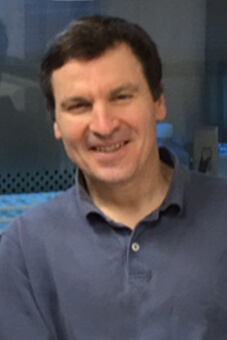
John G. Foley, PhD
Associate Professor of Anatomy, Cell Biology & Physiology
Associate Professor of Dermatology
Fellow, Indiana Molecular Biology Institute, College of Arts & Sciences, IU Bloomington
Adjunct Associate Professor of Biology, College of Arts & Sciences, IU Bloomington
- Phone
- (812) 855-3189
- Address
-
Health Sciences Building C3039
MSCI
BL
Bloomington, IN 47405 - PubMed:
-

Bio
BS: Univiersity of Wisconsin, Madison (Biochemistry)
Ph.D. Univeristy of Cincinnati College of Medicine (Anatomy and Cell Biology) thesis: Pheripherin as a marker for neuroblastoma. Thesis advisor: Linda Parysek
Post-doc: Yale University School of Medicine (Endocrinology) Research focus: regulation of PTHrP gene expression and PTHrP function in the skin. Advisor: Arthur E. Broadus
| Year | Degree | Institution |
|---|---|---|
| 1993 | PhD | University of Cincinnati |
| 1983 | BS | University of Wisconsin |
The Foley lab: Epithelia-Mesenchyme interactions that drive specialized skin function.
The skin is made up of two major layers: the outer most is the epidermis and this functions as a barrier protecting the organism from a myriad of insults; the inner layer is the dermis which a tough connective tissue that supports, nourishes and controls the differentiation of the epidermis. There have been tremendous advances identifying the signaling molecules and pathways that control epidermal differentiation and hair follicle cycling in skin that covers the body that is sometimes called trunk skin. However, mammals actually interface and manipulate their environment through small patches of specialized skin. These are largely hairless and include lips, palms, soles anal/genital regions and the nipple/areola. In these regions the epidermis is specialized exhibiting increased layers, altered cornification patterns, a lack of hair follicles and unique keratins. These characteristics are thought to result from molecular signals produced by distinct regional fibroblast populations at these sites. Little is known about signaling produced from these regional fibroblasts. Moreover, the role of other cell types present in these stromal niches has been ignored. In particular, sites of specialized skin contain abundant muscle in the dermis, providing the capacity to generate mechanical strain and respond to hormones that can substantially alter epidermis. Some examples of specialized epidermis change very little throughout life, but the human and mouse nipple/areola expands under the influence of pregnancy and lactation hormones, as well as the strain of nursing. Finally injuries to sites of specialized skin are notoriously difficult to repair.
My lab is interested in exploring the basic molecular and cellular biology of the nipple. The goal is to use this information to develop strategies to ameliorate structural defects (inverted nipples) and soreness/chapping of the appendage during nursing. In addition, mastectomies eliminate nipples in many breast cancer patients and satisfactory reconstruction options often are not available for this specialized skin. We intend to use the information gained from a basic studies to develop a cell-based regeneration nipple strategy for mastectomy victims.
My work with skin has broadened to include specialized appendages in non-mammalian vertebrates. In particular I have worked with my good friend Cheng-Ming Chuong’s lab on basic molecular and cell biology of the feather. This work has now includes collaborations with the songbird group here at IU biology. A key project underway is the molecular and cellular basis of the unusually long-tailed fowl developed in Japan. We believe these studies will provide insights into why humans grow extraordinarily long hair on their heads.
Desc: Trustees' Teaching Award
Scope: University
Date: 2021-05-01
Desc: Trustees' Teaching Award
Scope: University
Date: 2005-05-01